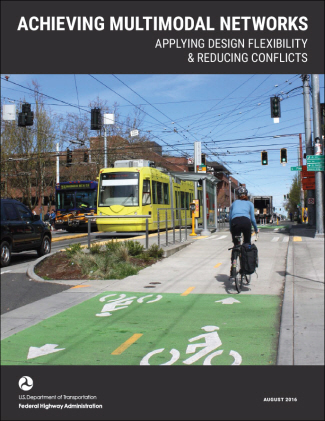 A new Federal Highway Administration report, Achieving Multimodal Networks: Applying Design Flexibility and Reducing Conflicts, highlights ways that planners and designers can apply the design flexibility found in current national design guidance to address common roadway design challenges and barriers. The report focuses on reducing multimodal conflicts and achieving connected networks so that walking and bicycling are safe, comfortable, and attractive options for people of all ages and abilities.
A new Federal Highway Administration report, Achieving Multimodal Networks: Applying Design Flexibility and Reducing Conflicts, highlights ways that planners and designers can apply the design flexibility found in current national design guidance to address common roadway design challenges and barriers. The report focuses on reducing multimodal conflicts and achieving connected networks so that walking and bicycling are safe, comfortable, and attractive options for people of all ages and abilities.
Accommodating and encouraging walking and bicycling often requires retrofitting constrained rights-of-way to include new or enhanced pedestrian and bicycle infrastructure. Greater awareness of the flexibility and versatility available in national guidance will help designers overcome many challenges related to both new and retrofit projects. In managing conflicts between modes, designers should understand that pedestrians are the most vulnerable roadway user because they are at the greatest risk of injury or death. Bicyclists generally travel at slower speeds than motor vehicles and are inherently more vulnerable in the event of a crash with a car, truck, or transit vehicle. Designers therefore need practical information based on real-world scenarios to address conflicts that occur between different modes.
The report is intended to:
- Equip planners, designers, and policy makers with information on designing safer, more comfortable, and accessible communities so that walking and wheeling are viable transportation choices for everyone, including seniors, children, and people with visual, mobility, and other disabilities.
- Equip planners, designers, and policy makers with information on designing safer, more comfortable, and connected transportation networks to make bicycling a viable transportation choice for people of all ages and abilities.
- Address common concerns and perceived barriers among design professionals concerned about liability when designing pedestrian and bicycle facilities.
- Direct planners and designers to existing national guidelines that provide specific information about flexible design treatments and approaches.